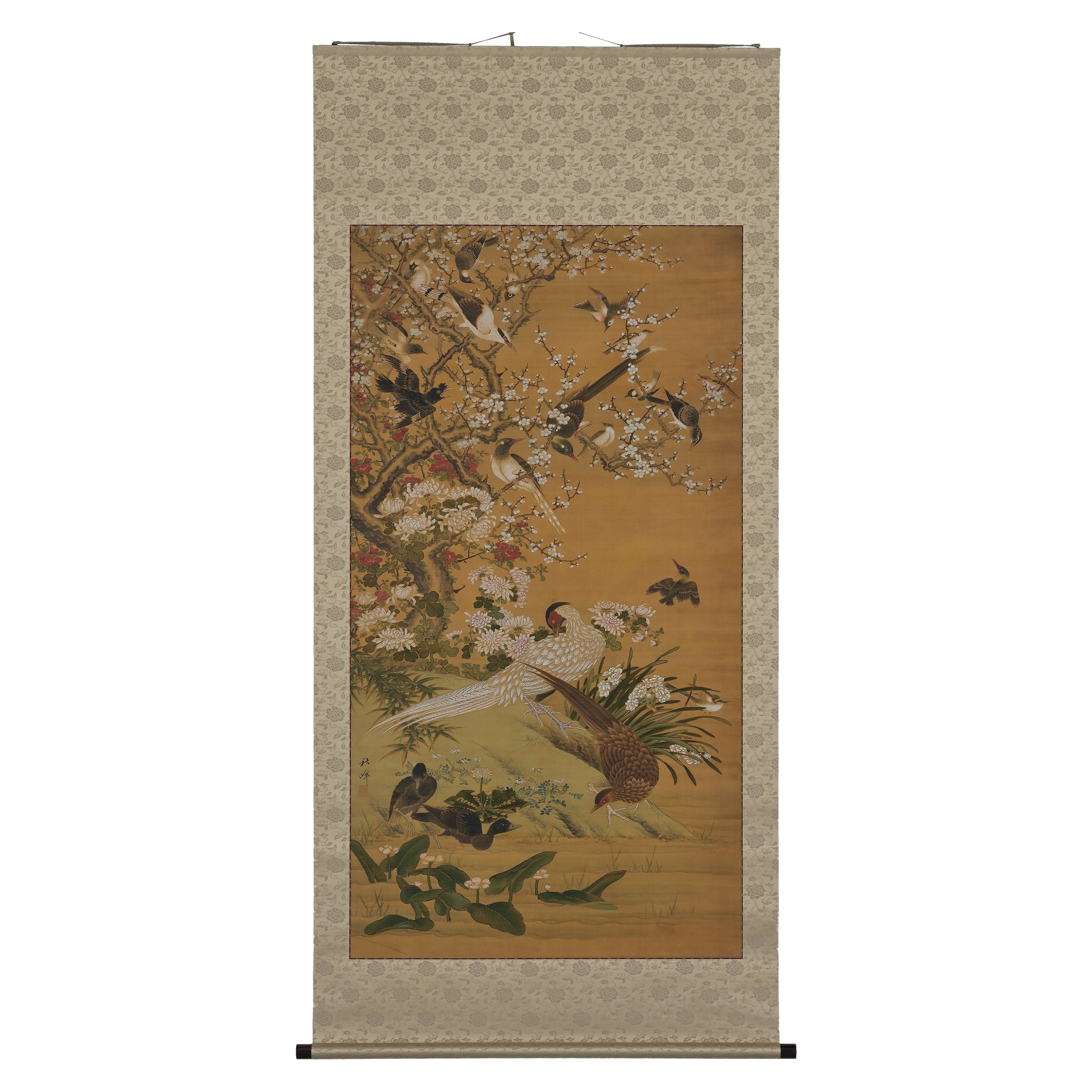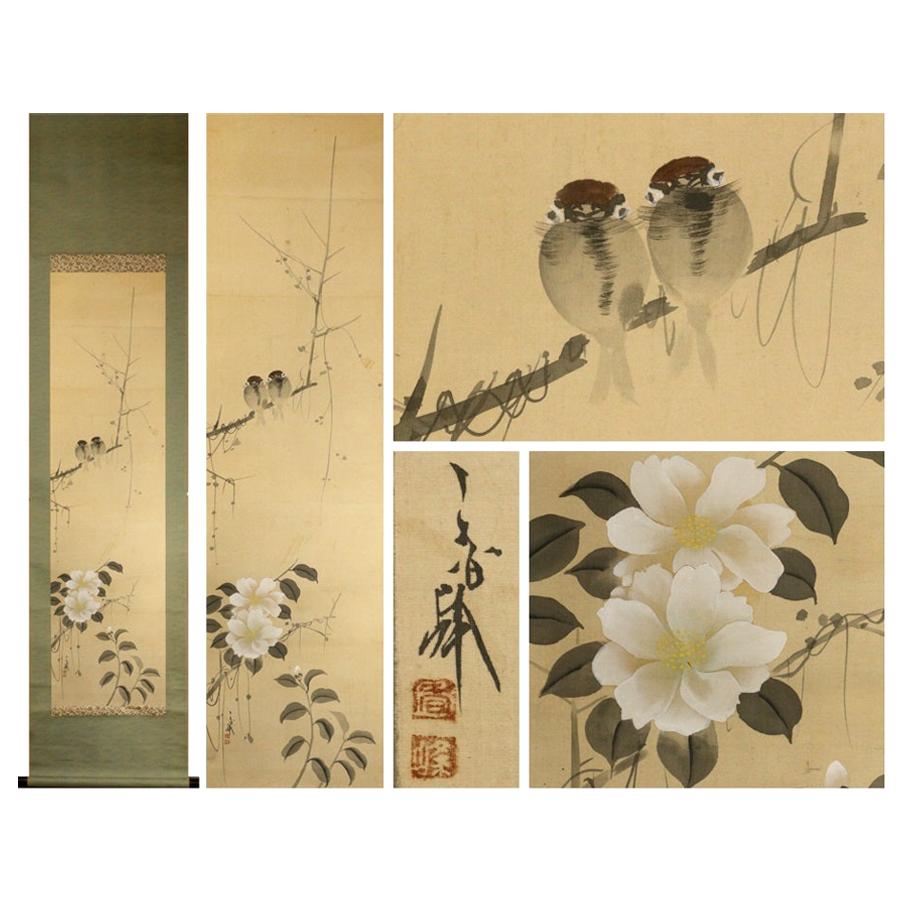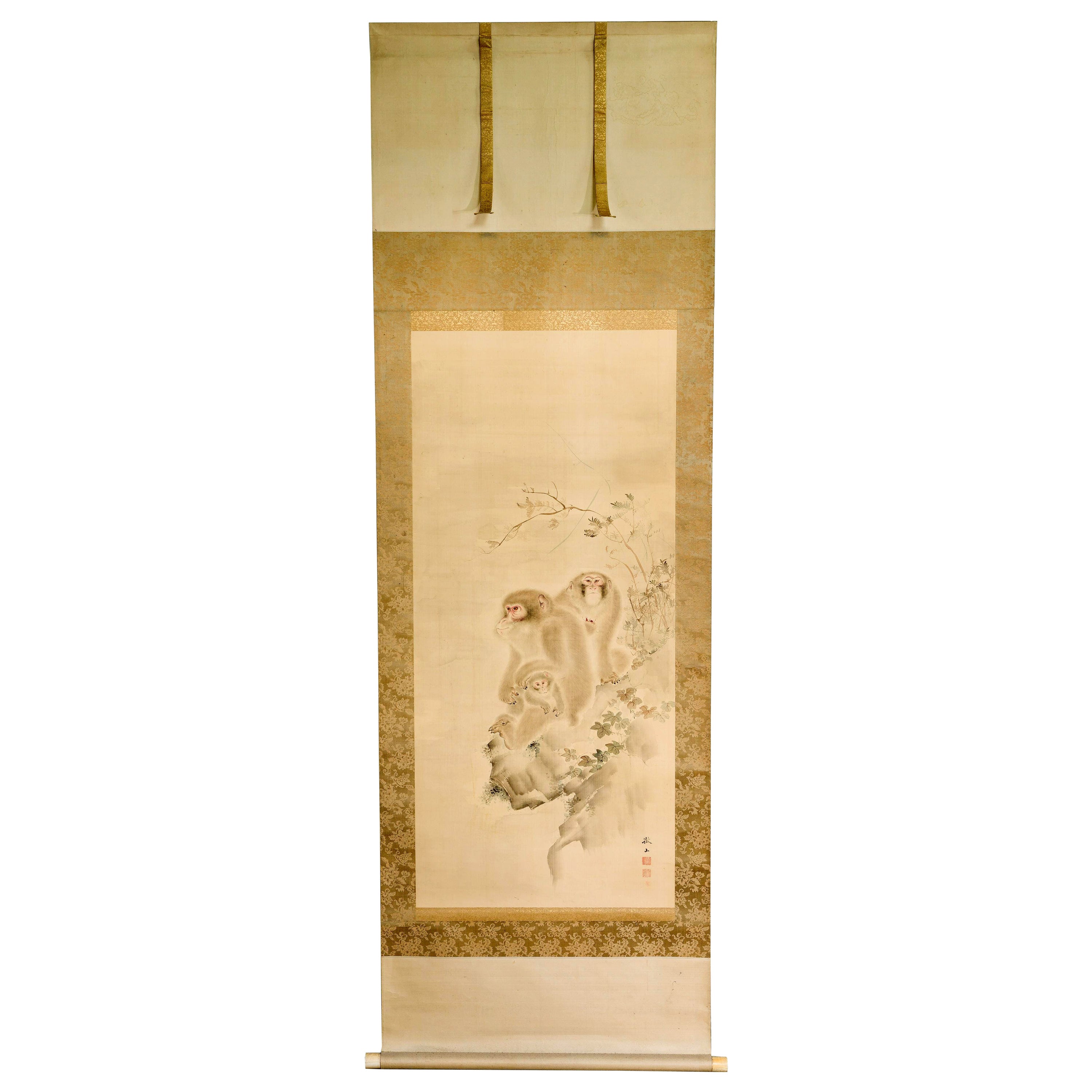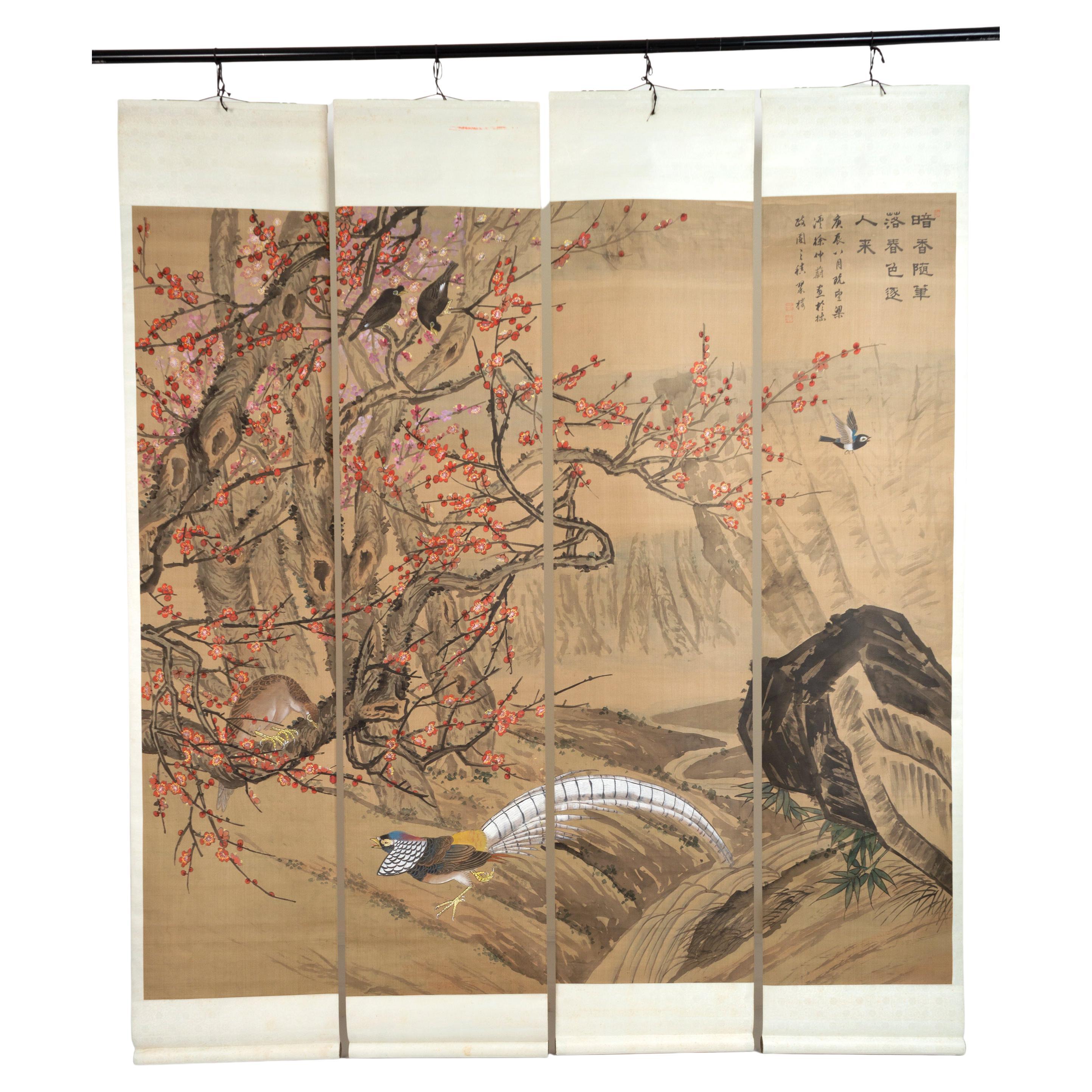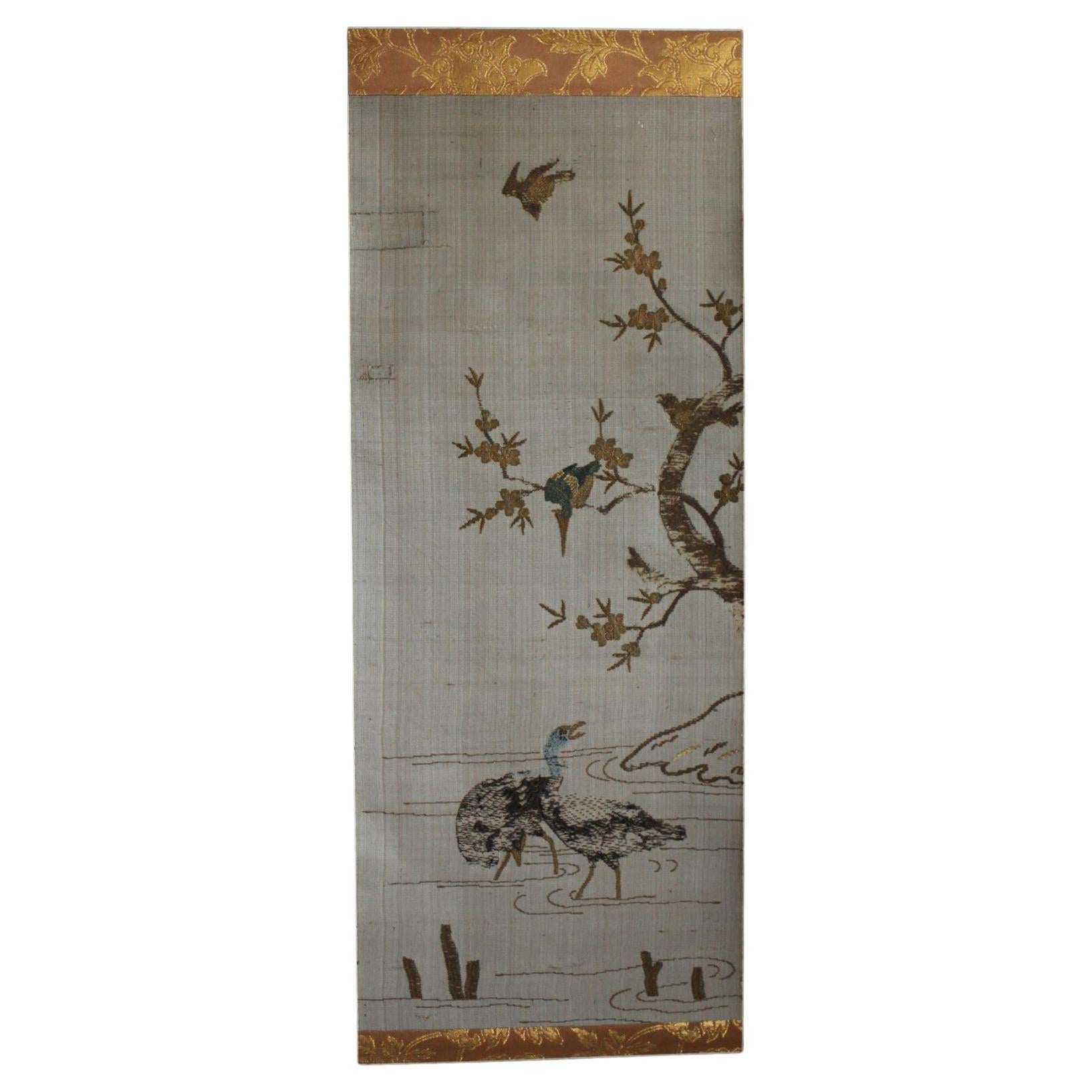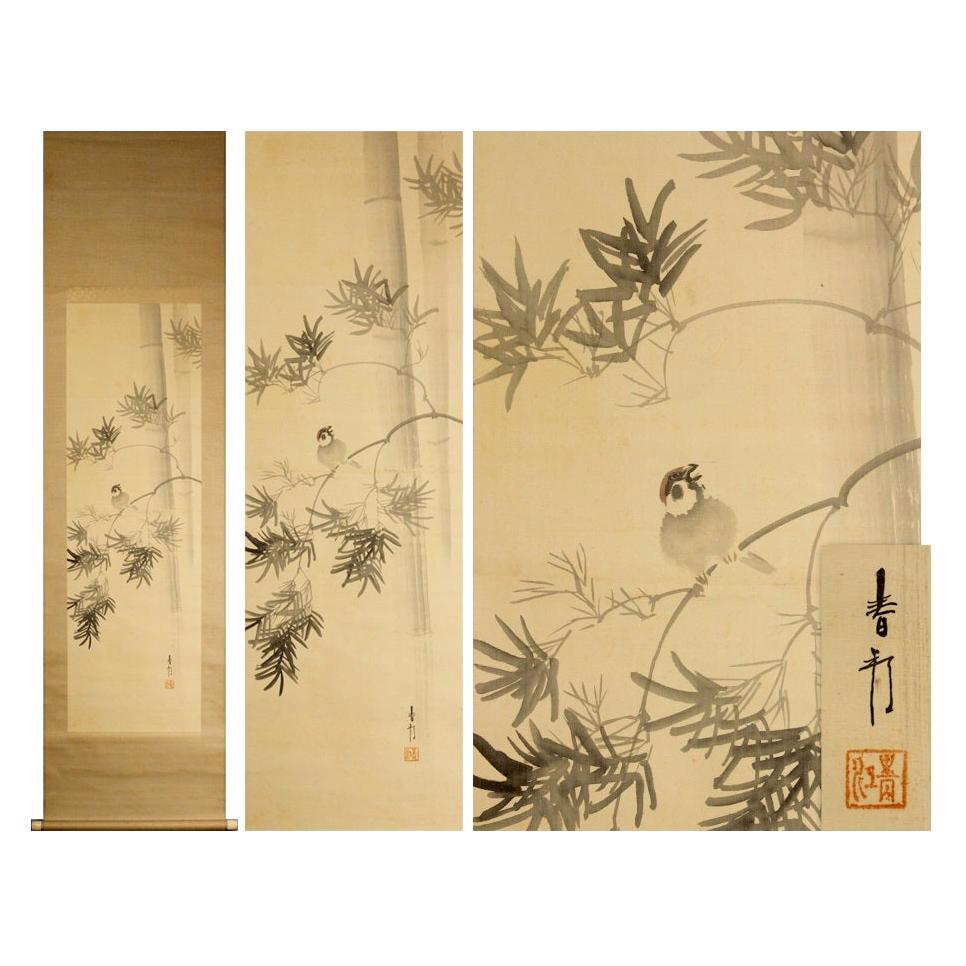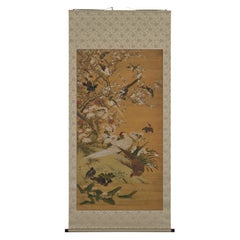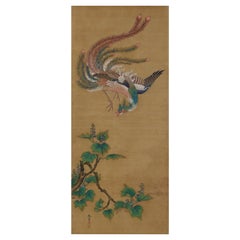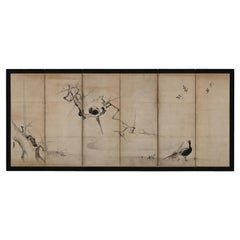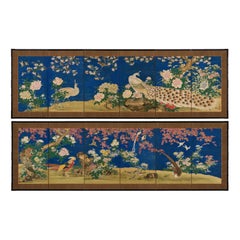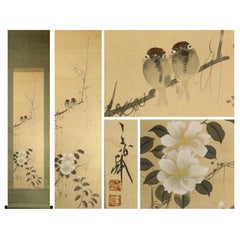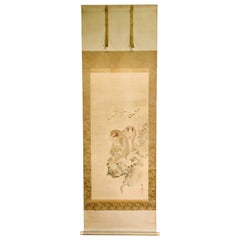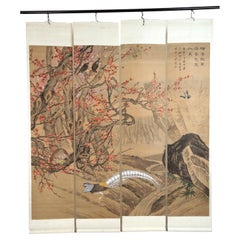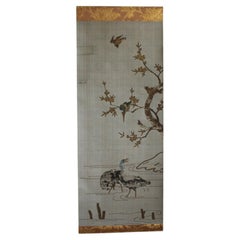Items Similar to Early 20th Century Japanese Nihonga Scroll. Crow & Persimmon.
Want more images or videos?
Request additional images or videos from the seller
1 of 8
Early 20th Century Japanese Nihonga Scroll. Crow & Persimmon.
$9,500
£7,251.92
€8,336.57
CA$13,368.20
A$14,865.99
CHF 7,807.94
MX$181,751.66
NOK 97,294.42
SEK 91,722.36
DKK 62,217.75
About the Item
Anonymous.
Crows & Persimmon
Japanese Scroll. Pigments and Ink on Silk.
Dimensions:
Scroll: H. 235 cm x W. 106 cm.
Image: H. 168 cm x W. 86 cm.
Bird and flower paintings are often linked to specific seasons and are used to represent the changing of nature throughout the year. In this work the ripened persimmons mark the season as late autumn. Here the artist has framed a pair of crows with an arc of persimmon and changing fall leaves.
The crows have been brushed in great detail and sharp focus in contrast to the softer forms of the leaves and fruit. The negative space surrounding them further enhances their intense realism. The branches are brushed with an eye to realism and naturalism, yet their lines and abrupt angles are beginning to exhibit some of the geometric organization of the 1930’s. A sunny naturalism flourished in Japanese painting in the first decades of the 20th century. This reached its height in the 1920s, and then quickly faded, supplanted by a mood of abstraction and stylization. By the early to mid 1930’s the individual expressive liberties that had informed the Taisho era (1912-1926) were being reined in and replaced with works of strong linearity and the flat application of saturated colors. This work serves as a link between the two distinct painting eras, effectively conveying the unbridled naturalism of the past and allowing us a glimpse into the more rigidly stylized future.
This oversized painting was most likely painted for exhibition. The signature and top seal read ‘Hiro’; the lower seal ‘Shofutsushi’. We haven’t been able to trace the artist. It is a common problem with works of the era as the disruption of imperialism and war cast a long and deep shadow over Japan. This elegant expression of a natural motif is painted firmly in the traditions of Nihonga. Nihonga, which literally means "Japanese-style painting," was a response to the Western influence that was prevalent during the late 19th and early 20th centuries but aimed to maintain and celebrate Japan's artistic heritage. Nihonga artists continued to employ traditional Japanese painting techniques, materials and subject matter though began to experiment with color palettes, compositions and brush techniques.
- Dimensions:Height: 92.5 in (234.95 cm)Width: 42 in (106.68 cm)Depth: 0.75 in (1.91 cm)
- Style:Taisho (Of the Period)
- Materials and Techniques:
- Place of Origin:
- Period:
- Date of Manufacture:Circa 1930
- Condition:Wear consistent with age and use.
- Seller Location:Kyoto, JP
- Reference Number:1stDibs: LU2472341917262
About the Seller
5.0
Recognized Seller
These prestigious sellers are industry leaders and represent the highest echelon for item quality and design.
Established in 2001
1stDibs seller since 2016
71 sales on 1stDibs
Typical response time: 16 hours
- ShippingRetrieving quote...Shipping from: Kyoto, Japan
- Return Policy
Authenticity Guarantee
In the unlikely event there’s an issue with an item’s authenticity, contact us within 1 year for a full refund. DetailsMoney-Back Guarantee
If your item is not as described, is damaged in transit, or does not arrive, contact us within 7 days for a full refund. Details24-Hour Cancellation
You have a 24-hour grace period in which to reconsider your purchase, with no questions asked.Vetted Professional Sellers
Our world-class sellers must adhere to strict standards for service and quality, maintaining the integrity of our listings.Price-Match Guarantee
If you find that a seller listed the same item for a lower price elsewhere, we’ll match it.Trusted Global Delivery
Our best-in-class carrier network provides specialized shipping options worldwide, including custom delivery.More From This Seller
View All19th Century Japanese Scroll Painting, Birds & Flowers of the Four Seasons
Located in Kyoto, JP
Birds and flowers of the four seasons
Early to mid-19th century
Ink, pigment and gofun on silk
Unidentified artist
Signature: S...
Category
Antique 1830s Japanese Edo Paintings and Screens
Materials
Silk
19th Century Japanese Silk Painting by Kano Chikanobu, Phoenix & Paulownia
Located in Kyoto, JP
Birds & Flowers of the seasons
Pheasants & Plum in Snow
Unframed painting. Ink, pigment and gofun on silk
Kano Chikanobu 1819-1888
Signature...
Category
Antique Mid-19th Century Asian Edo Paintings and Screens
Materials
Silk
17th Century Japanese Screen. Ink Plum Tree & Birds by Kano Naonobu.
Located in Kyoto, JP
Kano Naonobu (1607-1650)
Plum Tree and Birds
Six-fold Japanese Screen. Ink and slight color on paper.
In this evocative ink work spread over a six-panel folding screen, we see the consummation of the elegance and refinement of the Edo Kano school. This 17th century screen is a rare surviving example of a large-scale bird and flower painting by Kano Naonobu, the younger brother of Kano Tanyu...
Category
Antique 17th Century Japanese Edo Paintings and Screens
Materials
Wood, Paper
Mid 19th Century Japanese Screen Pair. Flowers & Birds of the Four Seasons.
Located in Kyoto, JP
Shioka Sorin (1781-1850)
Flowers & Birds of the Four Seasons
Pair of six-panel Japanese Screens. Ink, gofun and pigments on silk.
Dimensions (each screen): H. 91.5cm x W. 285cm (3...
Category
Antique Mid-19th Century Japanese Edo Paintings and Screens
Materials
Silk
Early 19th Century Japanese Screen. Cherry Blossom & Pheasants by Mori Tetsuzan
Located in Kyoto, JP
Mori Tetsuzan (1775-1841)
Pheasants and Cherry Blossoms
Two-fold Japanese screen. Ink, color, gofun, gold and silver on paper.
A two-fold Japanese bir...
Category
Antique Early 19th Century Japanese Edo Paintings and Screens
Materials
Gold Leaf
Japanese Painting. Bird and Flower. 19th century copy of Lu Ji by Ogata Tomin.
Located in Kyoto, JP
Ogata Tomin (1839 -1895)
Birds in a spring landscape
Ink and colour on silk.
Inscription reads:
“Copy of Lu Ji, painted with heartfelt appreciation”
“Painted by Tomin Ogat...
Category
Antique Late 19th Century Japanese Ming Paintings and Screens
Materials
Silk
You May Also Like
Artists Kashiro Ashimi Meiji Period Bird Scroll Japan 20c Artist Nihonga
Located in Amsterdam, Noord Holland
As you can see, Kashiro Asami brush flower and bird (sparrow) figure Axle.
In addition to the flowers expressed in simple yet calm shades, the
bird (sparrow) seen at the top is a w...
Category
20th Century Japanese Showa Paintings and Screens
Materials
Silk
$739 Sale Price
20% Off
Japanese Silk Scroll Painting of Moneys Edo Period Mori Tetsuzan
Located in Atlanta, GA
A Japanese mounted vertical hanging scroll painting by Mori Tetsuzan (Japanese, 1775-1841) circa 19th century Edo period. The watercolor and ink on silk ...
Category
Antique 19th Century Japanese Japonisme Paintings and Screens
Materials
Silk, Paper
Set of Four Japanese Silk Hanging Scrolls Screens C.1920
Located in London, GB
A stunning set of four Japanese silk mounted vertical hanging scrolls.
Dating from C.1920 Taisho Period.
The watercolour and ink on silk depicts a larg...
Category
Vintage 1920s Japanese Japonisme Paintings and Screens
Materials
Silk
$5,942 Sale Price / set
20% Off
Japanese Antiques Takeya-machi embroidery, bird picture, hanging scroll
Located in Niiza, JP
Embroidery, scroll tip: wood
Embroidery Size: 320 (W) x 760 (H) [mm],
Overall: 470 (W) x 1650 (H) [mm]
Box size: 80×70×630㎜ 800g
Takeya-machi embroidery has a long history.
When T...
Category
Antique Early 19th Century Japanese Textiles
Materials
Paper
Artists Miyao Jujin, Showa Period Bird and Plum Scroll Japan 20c Artist Nihonga
Located in Amsterdam, Noord Holland
As you can see, this work depicts a sparrow in a bamboo grove with sunlight shining through it.
¦ Silk book / handwriting.
¦
There are some discolorations in the state era.
...
Category
20th Century Japanese Showa Paintings and Screens
Materials
Silk
$739 Sale Price
20% Off
Japanese Hanging Scroll, Late 19th Century
Located in New York, NY
A Japanese hanging scroll or Kakejiku, circa 1890, depicting bamboo grass and a rabbit, framed by top and bottom ribbons of brocade silk.
In ...
Category
Antique 1890s Japanese Meiji Paintings
Materials
Silk, Paper
$2,624 Sale Price
20% Off
More Ways To Browse
Antique Scroll
Framed Scrolls
Japanese Antique Marks
Ink Scroll
Japanese Brushes
Japanese Scroll Flower
Antique Japanese Scroll Painting
Persimmon Art
Japanese Silk Painting Ink
20th Japan Painting On Silk
Pair Of Japanese Screens
Framed Silk Art Birds
Scroll Japanese Birds
Antique Crow
Bird Paintings On Silk
Asian Painted Scrolls
Japanese Silk Screen Flowers
Japanese Brush Painting
